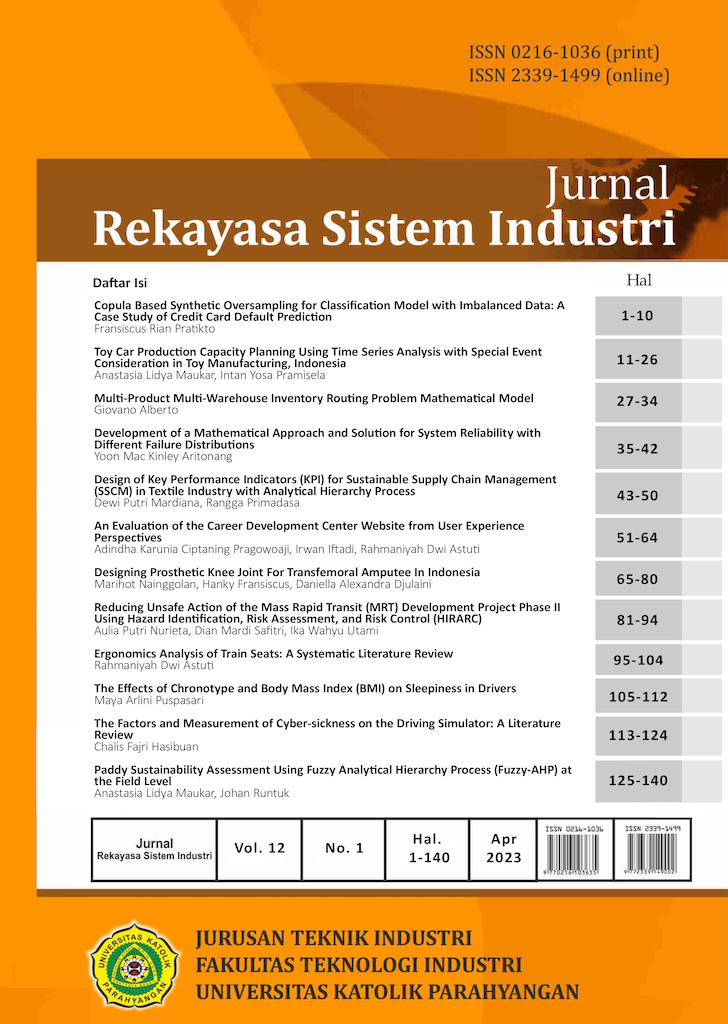Multi-Product Multi-Warehouse Inventory Routing Problem Mathematical Model
DOI:
https://doi.org/10.26593/jrsi.v12i1.6371.27-34Keywords:
inventory, routing, multi-product, multi-warehouseAbstract
Every business always aims to make significant profits. The corporation can cut expenses in one way or another. Logistics is one of the most expensive operations, and two-thirds of its expenditures are related to inventory and transportation. Inventory and transportation challenges must be addressed simultaneously in the supply chain to achieve the best results.This problem is modeled in the inventory routing problem (IRP). The development of the IRP model still has gaps with real conditions. The IRP model designed has not yet discussed the Multi-product Multi-warehouse Inventory Routing Problem (MMIRP) model. MMIRP takes into account the conditions of the types of goods that need to be sent, which vary and there are several warehouses that have goods of different types in one period of time. The results obtained after completing the model are the number of vehicles used, the number of goods of each type shipped, the travel routes generated by each vehicle, and the large costs generated based on the route design and inventory at each location.
References
Andersson, H., Hoff, A., Christiansen, M., Hasle, G. and Løkketangen, A. (2010), “Industrial aspects and literature survey: Combined inventory management and routing”, Computers and Operations Research, September, doi: 10.1016/j.cor.2009.11.009.
Archetti, C., Bertazzi, L., Hertz, A. and Grazia Speranza, M. (2012), “A hybrid heuristic for an inventory routing problem”, INFORMS Journal on Computing, Vol. 24 No. 1, pp. 101–116, doi: 10.1287/ijoc.1100.0439.
Bertazzi, L. and Speranza, M.G. (2012), “Inventory routing problems: an introduction”, EURO Journal on Transportation and Logistics, Elsevier BV, Vol. 1 No. 4, pp. 307–326, doi: 10.1007/s13676-012-0016-7.
Campbell, A.M. and Savelsbergh, M.W.P. (2004), “A decomposition approach for the inventory-routing problem”, Transportation Science, INFORMS Inst.for Operations Res.and the Management Sciences, Vol. 38 No. 4, pp. 488–502, doi: 10.1287/trsc.1030.0054.
Cao, J., Gao, J., Li, B. and Wang, X. (2020), The Inventory Routing Problem: A Review.
Coelho, L.C., Cordeau, J.F. and Laporte, G. (2014), “Thirty years of inventory routing”, Transportation Science, INFORMS Inst.for Operations Res.and the Management Sciences, Vol. 48 No. 1, pp. 1–19, doi: 10.1287/trsc.2013.0472.
Hewitt, M., Nemhauser, G., Savelsbergh, M. and Song, J.H. (2013), “A branch-and-price guided search approach to maritime inventory routing”, Computers and Operations Research, Vol. 40 No. 5, pp. 1410–1419, doi: 10.1016/j.cor.2012.09.010.
Lmariouh, J., Hachemi, N. el, Jamali, A. and Bouami, D. (2014), “The multi-vehicle mutli-product inventory-routing problem: A case study”, 2014 International Conference on Advanced Logistics and Transport, ICALT 2014, IEEE Computer Society, pp. 319–323, doi: 10.1109/ICAdLT.2014.6866332.
Moin, N.H. and Salhi, S. (2007), “Inventory routing problems: A logistical overview”, Journal of the Operational Research Society, Palgrave Macmillan Ltd., 26 September, doi: 10.1057/palgrave.jors.2602264.
Persson, J.A. and Göthe-Lundgren, M. (2005), “Shipment planning at oil refineries using column generation and valid inequalities”, European Journal of Operational Research, Vol. 163 No. 3, pp. 631–652, doi: 10.1016/j.ejor.2004.02.008.
Qu, W.W., Bookbinder, J.H. and Iyogun, P. (1999), An Integrated Inventory-Transportation System with Modified Periodic Policy for Multiple Products.
Ronen, D. (1993), Invited Review Ship Scheduling: The Last Decade, European Journal of Operational Research, Vol. 71.
Yeh, Y. and Low, C. (2017), “Mathematical Modelling for a Multi-Product Inventory Routing Problem with Split Delivery”, Journal of Applied Mathematics and Physics, Scientific Research Publishing, Inc, Vol. 05 No. 09, pp. 1607–1612, doi: 10.4236/jamp.2017.5913

